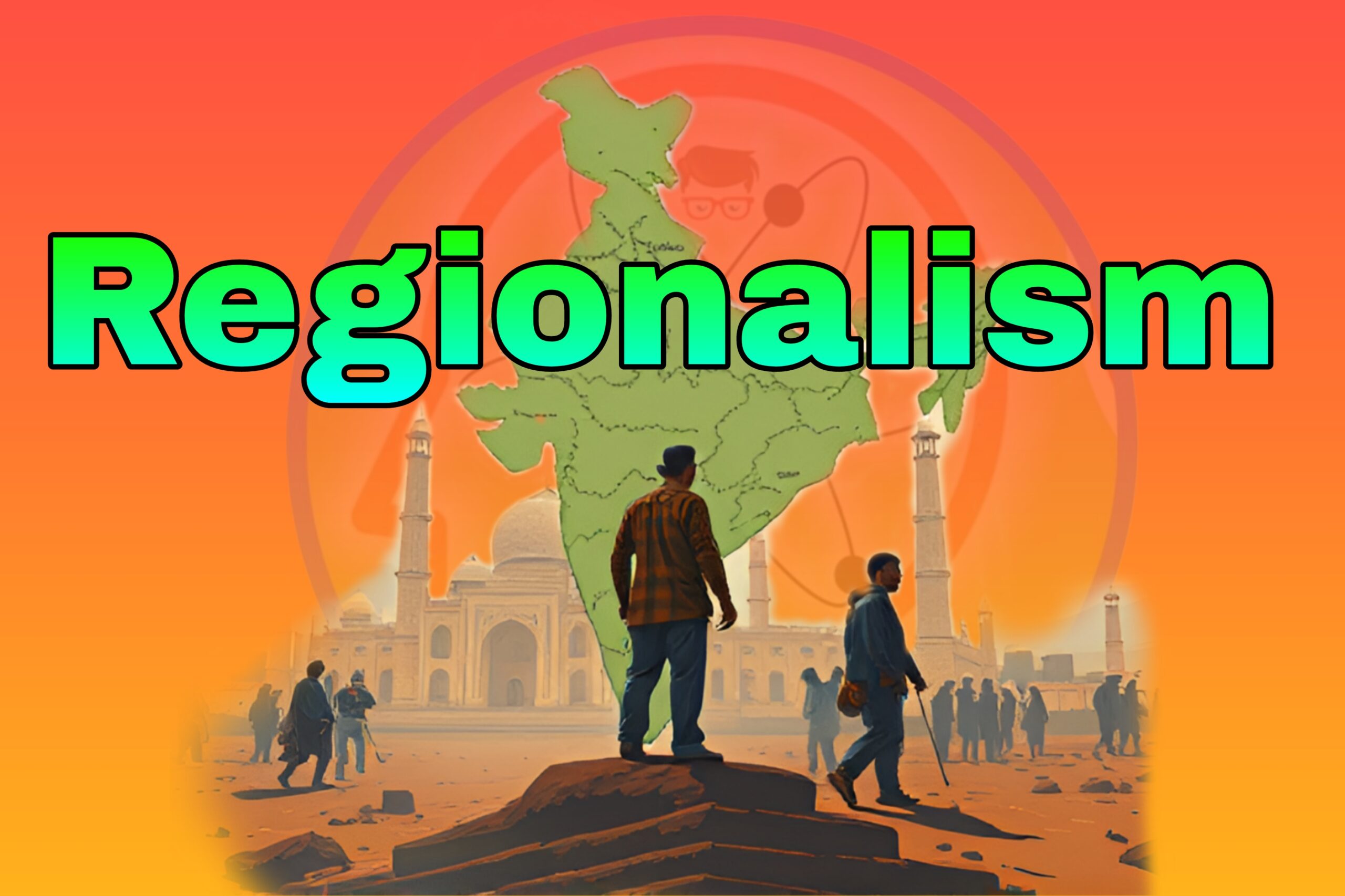Regionalism in India

1. Defining Regionalism
Regionalism is a political ideology that prioritizes the interests of a region over the country as a whole. It is characterized by an exaggerated attachment to a region, and often involves advocating for more autonomy, control, or decision-making power for the region.
Regionalism can be based on a region’s unique cultural, economic, historical, or geographical characteristics. For example, in India, regionalism can be based on linguistic aspirations, ethnicity, or the insider-outsider complex.
Regionalism can have both positive and negative impacts on a country:—
1.1 Positive Aspects of Regionalism
- Cultural Appreciation:— In its positive sense, regionalism reflects people’s deep appreciation for their cultural heritage, language, and the unique characteristics of their region.
- Identity Preservation:— It helps communities maintain a distinct cultural identity within a larger national framework.
1.2 Negative Aspects of Regionalism
- Excessive Attachment:— When regionalism takes a divisive form, it can lead to an excessive attachment to a particular region over the national identity, risking national unity and integrity.
- Potential for Conflict:— Such a form of regionalism may create internal divisions and hinder the collective progress of the country.
2. Roots of Regionalism in Colonial India
2.1 British Rule and Regional Disparities
- Imposed Unity:— British rule imposed a form of unity on a culturally diverse India, yet it also created disparities across different regions.
- “Divide and Rule” Strategy:— The British exploited these regional differences to maintain control over India through a “divide and rule” strategy, which intensified regional identities.
2.2 Linguistic Identity as Regional Identity
- Pre-Independence Movements:— Even before independence, there were demands to reorganize states along linguistic lines, as language became a significant aspect of regional identity.
2.3 Post-Independence Challenges
- Partition and Unity:— Following the trauma of partition, national leaders initially postponed any reorganization based on regional identities, prioritizing national unity.
3. Regionalism in Post-Independence India
3.1 Demand for Linguistic States
- Potti Sriramulu’s Hunger Strike:— The call for linguistic states intensified with Potti Sriramulu’s hunger strike in 1952, which ultimately led to the formation of Andhra Pradesh as the first state based on language.
- Rise of Regional Political Aspirations:— The 1960s marked a significant turn when the Dravida Munnetra Kazhagam (DMK) defeated the Indian National Congress (INC) in Tamil Nadu, showcasing a powerful regional political identity.
3.2 Formation of New States and Changes in Status
- New States in 2000:— Jharkhand, Chhattisgarh, and Uttarakhand were carved out of Bihar, Madhya Pradesh, and Uttar Pradesh, respectively, addressing regional aspirations for autonomy.
- Telangana and Jammu & Kashmir:— Telangana was created as a separate state from Andhra Pradesh in 2014, while Jammu & Kashmir saw a major change in 2019, when it was reorganized and its statehood was revoked.
3.3 Constitutional Mechanisms Supporting Regional Diversity
- Federal Structure:— India’s federal structure allows for regional autonomy within a unified national framework, giving each state some control over its own governance.
- Recognition of Diversity:— The Constitution respects India’s diversity by recognizing various political, linguistic, and cultural identities.
- Political Alliances:— The formation of political alliances incorporating regional parties allows for the representation of regional interests at the national level.
- Democratic Principles:— India’s democratic structure supports regional representation, enabling regions to voice their unique needs and issues through electoral processes.
4. Causes and Types of Regionalism
4.1 Causes of Regionalism
- Heterogeneous Character of India:— India’s diverse social fabric has led to a variety of regional demands and aspirations.
- Perceived Neglect and Resource Distribution:— Regionalism often arises from feelings of neglect or unequal resource distribution among states.
- Cultural, Ethnic, Religious, or Linguistic Identity:— Strong regional identities can emerge from a shared language, ethnicity, or cultural heritage.
- Political Manipulation:— Sometimes, regionalism is fueled by political forces that capitalize on local grievances and sentiments to promote regional aspirations.
4.2 Types of Regionalism
- Linguistic Regionalism:— Language is a powerful marker of identity in India. For example, the Dravidian movements in Tamil Nadu emerged to protect the interests of Tamil speakers.
- Economic and Developmental Regionalism:— Economic disparities and developmental issues often fuel regionalism. The Telangana movement in Andhra Pradesh arose due to economic inequalities and administrative neglect.
- Ethnic Regionalism:— Ethnic differences can drive regionalism, as seen in Assam’s Bodoland movement, where ethnic identity was a key factor.
- Religious and Cultural Regionalism:— In some cases, regionalism is linked to shared religious or cultural practices that create a distinct identity within a larger national framework.
- Political and Administrative Regionalism:— Administrative autonomy and political representation are also common demands in regions that feel marginalized or underrepresented.
5. Comparative Perspectives on Regionalism in India and China
5.1 China’s Approach: “One Country, Two Systems”
- Concept:— China maintains national unity by offering distinct governance models to certain regions through its “One Country, Two Systems” approach, especially for integrating regions like Hong Kong and Macau.
- Deng Xiaoping’s Vision:— Originally proposed by Deng Xiaoping, this approach allows these regions to retain some autonomy while remaining part of China.
5.2 India’s Approach: Managing Regionalism through Federalism
- Secessionist Challenges:— India, as a postcolonial nation, has encountered various separatist and secessionist movements. However, it has generally managed these aspirations by balancing regional autonomy with national unity.
- Comparative Success:— Compared to China, India has had relatively greater success in containing regionalism through constitutional provisions, political alliances, and democratic processes.
6. The Role of Regionalism in India’s Unity and Diversity
Regionalism in India is a double-edged sword: while it has potential to deepen social divides, it can also serve as a source of cultural pride and identity. India has managed to strike a delicate balance through federalism, respect for diversity, and inclusive governance. Regionalism, when constructively engaged, can reinforce India’s unity in diversity, allowing for a nation where various identities coexist within a shared framework of national solidarity.
Source :— Indian Express
#Regionalism in India
#Regionalism in India
#Regionalism in India
#Regionalism in India
